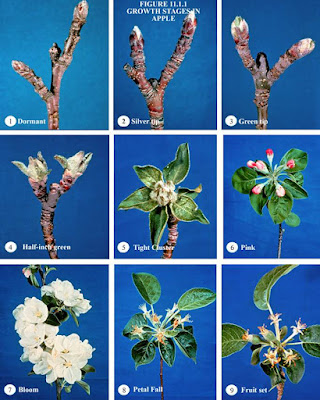By Amy Lentz, Boulder County CSU Extension
One can grow several different types of fruit trees in
Colorado with some performing better than others depending on where and at what
elevation you live. Along the Front Range, apples and cherries used to be staple
industries prior to the 1950’s. A few rough weather years along with changing market
forces moved the industries to other states, but these types of fruit trees
along with pears and plums can be quite fruitful (pardon the pun) along the
Front Range. Other types of fruit trees will struggle in this region to produce
a crop, whereas if you are on the Western Slope, several different types of
fruit trees will give you a dependable fruit crop due to the benefit of warmer
winds…perfect for growing those coveted peaches.
A lot of the potential to get a decent harvest from a fruit
tree in Colorado boils down to phenology. What’s that, you ask? Phenology
is a branch of science dealing with the relationship between climate and
periodic biological phenomena (definition from Merriam-Webster) such as
bird migrations and, in this case, flowering patterns of plants. In more simple
terms, this is often referred to as bloom stage or growth stage. Fruit trees
will go through various bloom stages as they wake up each spring. For example,
apple trees have nine stages of blooms from dormant to fruit set as seen in
this pictorial chart from Cornell University:
 |
| Apple Phenology Chart - Cornell University |
Back to why it’s not easy to have a productive fruit tree in
Colorado…springtime frosts! It’s safe to say that you never know when that last
spring frost will come in Colorado. And when it does, how low will it go? This
is the key to whether or not you will get a decent fruit crop from year to year
– it’s the combination of the low temperatures experienced in the spring and the
stage of bloom at that time. For example, if your leaves and/or flowers are
just starting to emerge (at the ‘green tip’ stage of development), your tree’s
flower buds can take some pretty low temperatures and can easily survive a light
frost. However, if you tree is in full bloom, you will lose many of those
flowers if the temperatures dip a just a few degrees below freezing. The
following chart shows the various bloom stages for tart and sweet cherry and
peaches:
 |
| % Bloom Loss vs. Temperature vs. Bloom Stage - Utah State University |
Notice for tart cherries that even at temperatures down to 15° F, only 10% of the blooms will be damaged or killed if they are just swollen and have not broken through yet. Conversely, with that same tree in full bloom, you will see around 90% of the blooms (and future fruit) damaged or killed if the temperature gets down to just 25° F. The relationship is similar for peaches and other fruit trees, as well. Simply put, the further along in bloom, the more susceptible the buds are to being killed by a spring frost.
 |
Undamaged peach flower bud compared to damaged bud after exposure to very low temperatures (-15°F). Photos: Amy Lentz |
Throw in crazy Colorado weather and it’s a fool’s bet! The
timing of these stages will vary from year to year, making it hard to predict
when your tree will be in full bloom. The following photos were taken
in the Fort Collins area in 2017 for an apple tree. The dates of each stage of
flower are marked above each picture taken of the same branch over time. Just one
year later in 2018, the same tree was more than two weeks later in its timing
for each bloom stage.
Pink Stage occurred on April 12, 2017. In 2018, the same stage occurred about 16 days later, showing up on April 28th. Photos: Amy Lentz |



very helpful. thank you.
ReplyDeleteExcellent article on the challenges of getting fruit trees to produce. Not only is sneaking past a spring freeze an uncontrollable quest, but then you have to contend with all the vermin that wants to take your crop, insects, disease, rodents, birds, all want a piece of the action. I planted a Red Haven peach tree and one season out of thirteen the tree produced 6 peaches. And then the wasps, birds, and squirrels tried to beat me to them. Point being if you plant a fruit tree plant it for reasons other than expecting a crop.
ReplyDelete